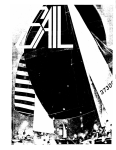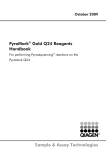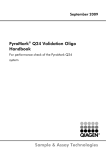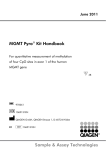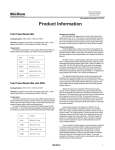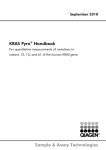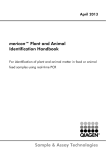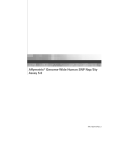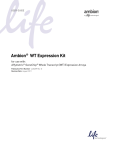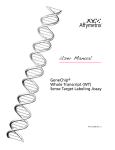Download Type-it® HRM™ PCR Handbook
Transcript
1057433_HB 29.05.2009 11:47 Uhr Seite 1 July 2009 Type-it® HRM™ PCR Handbook For detection of gene mutations and SNPs by high-resolution melting (HRM) analysis Sample & Assay Technologies 1057433_HB 29.05.2009 11:47 Uhr Seite 2 QIAGEN Sample and Assay Technologies QIAGEN is the leading provider of innovative sample and assay technologies, enabling the isolation and detection of contents of any biological sample. Our advanced, high-quality products and services ensure success from sample to result. QIAGEN sets standards in: ■ Purification of DNA, RNA, and proteins ■ Nucleic acid and protein assays ■ microRNA research and RNAi ■ Automation of sample and assay technologies Our mission is to enable you to achieve outstanding success and breakthroughs. For more information, visit www.qiagen.com. 1057433_HB 29.05.2009 11:47 Uhr Seite 3 Contents Kit Contents 4 Storage 4 Product Use Limitations 4 Product Warranty and Satisfaction Guarantee 5 Technical Assistance 5 Safety Information 6 Product Specifications 6 Quality Control 6 Introduction 7 HRM (High-Resolution Melting) 7 General considerations for genotyping by HRM 9 Cyclers 11 Equipment and Reagents to Be Supplied by User 12 Important Notes 13 Protocols ■ Analysis of Gene Mutations and Microbial Genetic Differences by HRM 14 ■ Analysis of SNPs by HRM 21 Troubleshooting Guide 28 Appendix A: HRM Instrument Setup and Data Analysis 30 Appendix B: Starting Template 30 Appendix C: Designing and Handling Primers 30 Ordering Information 33 Type-it HRM PCR Handbook 07/2009 3 1057433_HB 29.05.2009 11:47 Uhr Seite 4 Kit Contents Type-it HRM PCR Kit Catalog no. Number of 25 µl reactions 2x HRM PCR Master Mix containing: ■ HotStarTaq® Plus DNA Polymerase ■ Type-it HRM PCR Buffer (with EvaGreen® dye) ■ Q-Solution® ■ dNTP mix (dATP, dCTP, dGTP, dTTP) RNase-Free Water Handbook (100) (400) 206542 206544 100 400 1 x 1.3 ml 4 x 1.3 ml 1 x 2 ml 2 x 2 ml 1 1 Storage The Type-it HRM PCR Kit is shipped on dry ice. The kit should be stored immediately upon receipt at –20°C in a constant-temperature freezer and protected from light. When stored under these conditions and handled correctly, this product can be stored at least until the expiration date (see the inside of the kit lid) without showing any reduction in performance. 2x HRM PCR Master Mix can be stored at 2–8°C for up to 2 months without showing any reduction in performance. Product Use Limitations The Type-it HRM PCR Kit is intended for molecular biology applications. This product is neither intended for the diagnosis, prevention, or treatment of a disease, nor has it been validated for such use either alone or in combination with other products. Therefore, the performance characteristics of the products for clinical use (i.e., diagnostic, prognostic, therapeutic, or blood banking) are unknown. All due care and attention should be exercised in the handling of the products. We recommend all users of QIAGEN® products to adhere to the NIH guidelines that have been developed for recombinant DNA experiments, or to other applicable guidelines. 4 Type-it HRM PCR Handbook 07/2009 1057433_HB 29.05.2009 11:47 Uhr Seite 5 Product Warranty and Satisfaction Guarantee QIAGEN guarantees the performance of all products in the manner described in our product literature. The purchaser must determine the suitability of the product for its particular use. Should any product fail to perform satisfactorily due to any reason other than misuse, QIAGEN will replace it free of charge or refund the purchase price. We reserve the right to change, alter, or modify any product to enhance its performance and design. If a QIAGEN product does not meet your expectations, simply call your local Technical Service Department or distributor. We will credit your account or exchange the product — as you wish. Separate conditions apply to QIAGEN scientific instruments, service products, and to products shipped on dry ice. Please inquire for more information. A copy of QIAGEN terms and conditions can be obtained on request, and is also provided on the back of our invoices. If you have questions about product specifications or performance, please call QIAGEN Technical Services or your local distributor (see back cover or visit www.qiagen.com). Technical Assistance At QIAGEN, we pride ourselves on the quality and availability of our technical support. Our Technical Service Departments are staffed by experienced scientists with extensive practical and theoretical expertise in sample and assay technologies and the use of QIAGEN products. If you have any questions or experience any difficulties regarding the Type-it HRM PCR Kit or QIAGEN products in general, please do not hesitate to contact us. QIAGEN customers are a major source of information regarding advanced or specialized uses of our products. This information is helpful to other scientists as well as to the researchers at QIAGEN. We therefore encourage you to contact us if you have any suggestions about product performance or new applications and techniques. For technical assistance and more information, please see our Technical Support Center at www.qiagen.com/Support or call one of the QIAGEN Technical Service Departments or local distributors (see back cover or visit www.qiagen.com). Type-it HRM PCR Handbook 07/2009 5 1057433_HB 29.05.2009 11:47 Uhr Seite 6 Safety Information When working with chemicals, always wear a suitable lab coat, disposable gloves, and protective goggles. For more information, please consult the appropriate material safety data sheets (MSDSs). These are available online in convenient and compact PDF format at www.qiagen.com/support/MSDS.aspx where you can find, view, and print the MSDS for each QIAGEN kit and kit component. 24-hour emergency information Emergency medical information in English, French, and German can be obtained 24 hours a day from: Poison Information Center Mainz, Germany Tel: +49-6131-19240 Product Specifications 2x HRM PCR Master Mix contains: HotStarTaq Plus DNA Polymerase: HotStarTaq Plus DNA Polymerase is a modified form of a recombinant 94 kDa DNA polymerase, originally isolated from Thermus aquaticus, cloned into E. coli. (Deoxynucleosidetriphosphate: DNA deoxynucleotidyl-transferase, EC 2.7.7.7). The enzyme is activated by a 5-minute, 95°C incubation step. Type-it HRM PCR Buffer: Novel PCR buffer for highly specific amplification with subsequent high-resolution melting analysis. EvaGreen: Novel dsDNA-binding fluorescent dye, allowing highly efficient and inhibition-free PCR amplification and ideally suited for HRM analysis. Q-Solution: For successful amplification of difficult genomic loci. Contained in the master mix at optimized concentration. dNTP mix: Contains dATP, dCTP, dGTP, and dTTP of ultrapure quality. RNase-free water: Ultrapure quality, PCR-grade. Quality Control In accordance with QIAGEN’s ISO-certified Quality Management System, each lot of Type-it HRM PCR Kit is tested against predetermined specifications to ensure consistent product quality. 6 Type-it HRM PCR Handbook 07/2009 1057433_HB 29.05.2009 11:47 Uhr Seite 7 Introduction The Type-it HRM PCR Kit is provided in a convenient master mix format for detection of gene mutations or SNPs via high-resolution melting analysis (HRM). HRM technology enables rapid characterization of DNA samples based on their melting behavior following PCR amplification. The kit contains the novel double-stranded DNA-binding fluorescent dye, EvaGreen, and includes an optimized HRM buffer and HotStarTaq Plus DNA Polymerase to eliminate nonspecific amplification products and provide reliable results. Q-Solution included in the master mix ensures specific amplification of difficult genomic loci, leading to successful results. The Type-it HRM PCR Kit facilitates multiple applications, including: ■ SNP genotyping ■ Mutation discovery ■ Scanning for mutations in disease and cancer-related genes ■ Identification of candidate predisposition genes ■ Genetic association studies ■ DNA fingerprinting ■ Species identification and genotyping For DNA methylation analysis by HRM, use the EpiTect® HRM PCR Kit. HRM (High-Resolution Melting) High-resolution melting analysis is an innovative technique that is based on analysis of DNA melting. HRM characterizes DNA samples according to their dissociation behavior as they transition from double-stranded DNA (dsDNA) to single-stranded DNA (ssDNA) with increasing temperature. Before performing HRM analysis, the target sequence must be amplified to a high-copy number in the presence of the dsDNA-binding fluorescent dye, EvaGreen. The dye does not interact with ssDNA but actively binds to dsDNA and fluoresces brightly when bound. Change in fluorescence can be used to measure the increase in DNA concentration during PCR and then to directly measure thermally-induced DNA melting by HRM. To perform high-resolution melting analysis, the temperature is increased from a lower to a higher temperature. The fluorescence of EvaGreen is measured continuously as the temperature is increased and is plotted against the temperature. EvaGreen fluoresces as long as it is bound to dsDNA. Due to the amplification procedure before the HRM analysis, fluorescence will be high at the beginning of the HRM analysis. Upon melting of dsDNA, EvaGreen is released and the fluorescence is reduced to a background level. Type-it HRM PCR Handbook 07/2009 7 1057433_HB 29.05.2009 11:47 Uhr Seite 8 HRM is easier and more cost-effective than probe-based genotyping assays and, unlike conventional methods, it is a closed-tube system that prevents contamination with PCR products. 2x HRM PCR Master Mix 2x HRM PCR Master Mix ensures highly specific amplification, as well as flexible, rapid, and sensitive analysis of gene mutations and SNPs, and enables genotyping via high-resolution melting. The components of 2x HRM PCR Master Mix include HotStarTaq Plus DNA Polymerase, Type-it HRM PCR Buffer, Q-Solution, and dNTPs. The optimized master mix ensures that the PCR products are amplified with high specificity and efficiency for successful HRM analysis even with difficult genomic loci. HotStarTaq Plus DNA Polymerase HotStarTaq Plus DNA Polymerase is a modified form of QIAGEN Taq DNA Polymerase, and is provided in an inactive state and has no enzymatic activity at ambient temperature. This prevents the formation of misprimed products and primer–dimers during reaction setup and the first denaturation step. Competition for reactants by PCR artifacts is therefore avoided, enabling high PCR specificity and accurate quantification. The enzyme is activated at the start of a reaction by a 5-minute, 95°C incubation step. The hot start enables reactions to be set up rapidly and conveniently at room temperature. EvaGreen EvaGreen is a novel fluorescent dye which selectively binds to dsDNA. Upon binding, fluorescence is strongly increased. The spectral properties of EvaGreen are very similar to those of SYBR® Green I. The absorbance maximum is 500 nm (with DNA bound) and the emission maximum is 530 nm. This allows easy detection of EvaGreen on channels/filters preset for HRM analysis and SYBR Green detection. In contrast to SYBR Green I, EvaGreen can be used in higher concentrations and shows equal binding affinity for GC-rich and AT-rich regions with no apparent sequence preference. This makes EvaGreen an ideal dye for HRM analyses of all types of PCR products. Protocol selection The Type-it HRM PCR Kit has been optimized for use with the following real-time cyclers: Rotor-Gene® Q, Rotor-Gene 6000, and LightCycler® 480. 8 Type-it HRM PCR Handbook 07/2009 1057433_HB 29.05.2009 11:47 Uhr Seite 9 This handbook contains 2 protocols for use with these cyclers. The Applied Biosystems® 7500 Fast System and Applied Biosystems 7900 can also be used with both optimized protocols in this handbook. Note that both instruments essentially require a dedicated calibration for the HRM dye in use before the experiment. A detailed protocol is provided at www.qiagen.com/Products/Type-itHRMPCRKit.aspx. ■ “Protocol: Analysis of Gene Mutations and Microbial Genetic Differences” is found on page 14 and is recommended for all HRM applications except SNP genotyping. ■ “Protocol: Analysis of SNPs by HRM” is found on page 21 and is recommended for SNP genotyping by HRM. General considerations for genotyping by HRM ■ Always check the real-time PCR instrument manual for details on HRM setup and analysis on your instrument. ■ Note that conventional melting curve analysis (as done for SYBR Green-based detection) and HRM are not the same. HRM requires dedicated reaction chemistry as well as an HRM real-time PCR instrument with dedicated heating algorithm and software. Template ■ Purified genomic DNA of every origin suitable for PCR with respect to purity and concentration can be used to successfully perform HRM with the Type-it HRM PCR Kit. ■ It is recommended to use the same genomic DNA purification procedure for all samples being analyzed by HRM. This avoids introduction of variations due to differing compositions of elution buffers used in different extraction methods. ■ To avoid any reduction in performance, we recommend using QIAGEN genomic DNA purification kits such as QIAamp® or DNeasy® Kits. ■ Use 1 ng to 50 ng of template genomic DNA or 1–50 pg microbial DNA per 25 µl reaction. ■ Important: Use comparable amounts of template genomic DNA for all samples resulting in CT values below 30 and differing by no more than 3 CT values. ■ It is recommended to use control DNA and sample DNA of comparable integrity. For example, for analyzing samples from FFPE-embedded tissues, control DNA should also be derived from FFPE tissues with comparable integrity. ■ DNA samples used for HRM should be normalized in concentration. All DNA samples should be quantified and then adjusted to the same concentration using the same dilution buffer. Type-it HRM PCR Handbook 07/2009 9 1057433_HB ■ 29.05.2009 11:47 Uhr Seite 10 Use sufficient PCR cycles so that all samples have reached the plateau phase of PCR to ensure that comparable amounts of PCR product are generated. Note that the amount of DNA affects the melting temperature of the PCR product. Check the protocols for details. Assay design Design assays with PCR product lengths of 70–350 bp. For SNP analysis, use of PCR products of 70–150 bp is recommended. Larger products can be analyzed successfully, but usually provide lower resolution. This is because, for example, a single base variation has a greater effect on the melting behavior of, for example, a 100 bp PCR product than on a 350 bp PCR product. Primers ■ Design primers allowing specific amplification. Perform a BLAST® search to ensure specific primer binding. See Appendix C, page 30 for details. ■ The melting temperature of primers used for PCR with subsequent HRM analysis should be at least 56°C. The melting temperature of primers can be calculated using the formula below: Tm = 2°C x (number of [A+T]) + 4°C x (number of [G+C]) ■ Whenever possible, design primer pairs with similar Tm values. ■ Check the concentration and integrity of primers before starting. Typically, standard primer quality primers are sufficient for HRM. For details, see Appendix C, page 30. ■ Important: Always start with a primer concentration of 0.7 µM HRM analysis It is required to initially determine the melting point for each new HRM PCR product. Run HRM analysis to span a temperature range from 65°–95°C, covering the full range of expected melting points. In future experiments, after determination of the Tm, you may run HRM from 5°C below the lowest Tm of all expected PCR products to 5°C above the highest Tm of all PCR products in your experiment. This may reduce the time required for HRM analysis. Data analysis Check that the PCR result contains only specific product. Samples showing post-PCR artifacts such as primer–dimers or nonspecific products can make HRM results difficult to interpret. The Type-it HRM PCR Kit ensures maximum specificity with minimal need for optimization. 10 Type-it HRM PCR Handbook 07/2009 1057433_HB 29.05.2009 11:47 Uhr Seite 11 Cyclers Rotor-Gene Q and Rotor-Gene 6000 QIAGEN’s real-time PCR cycler, the Rotor-Gene Q, combines multiple optimized design features to provide outstanding performance and reliable results for demanding research applications. The unique centrifugal rotary design of the Rotor-Gene Q makes it the most precise and versatile real-time PCR cycler currently available. Like the precursor model Rotor-Gene 6000, each tube spins in a chamber of moving air, keeping all samples at precisely the same temperature during rapid thermal cycling. Detection is similarly uniform. When each tube aligns with the detection optics, the sample is illuminated and the fluorescent signal is rapidly collected from a single, short optical pathway. This thermal and optical uniformity results in sensitive, precise, and fast HRM analysis. It also eliminates sample-to-sample variations and edge effects. The comprehensive Rotor-Gene Q software package supports all state-of-the-art HRM analysis procedures from basic to advanced algorithms. current Other real-time cyclers with HRM abilities The LightCycler 480 as well as the Applied Biosystems 7500 Fast System and the Applied Biosystems 7900 System also enable HRM analysis with purchase of dedicated software. The cyclers are block cyclers and have the advantage of working with standard PCR plate formats. However, during HRM analysis, less reproducible and less precise high-resolution melt values are obtained due to temperature gradients across the block and multiple, complex optical pathways. Type-it HRM PCR Handbook 07/2009 11 1057433_HB 29.05.2009 11:47 Uhr Seite 12 Equipment and Reagents to Be Supplied by User When working with chemicals, always wear a suitable lab coat, disposable gloves, and protective goggles. For more information, consult the appropriate material safety data sheets (MSDSs), available from the product supplier. ■ Primers: The Type-it HRM PCR Kit can be used with standard quality primers that can be purchased from established oligonucleotide manufacturers. Lyophilized primers should be dissolved in TE buffer to provide a stock solution of 100 µM; concentration should be checked by spectrophotometry. Primer solutions should be stored in aliquots at –20°C. Avoid repeated freeze/thaw cycles of primers. Prepare working solutions by dilution in TE (e.g., each primer at 10 µM) and store in small aliquots for single use. ■ Nuclease-free (DNase-free) consumables: special care should be taken to avoid nuclease contamination of all reagents and consumables used to set up PCR. ■ Optical PCR tubes or plates (use thin-walled PCR tubes or plates recommended by the manufacturer of your real-time cycler). ■ Optional: Trizma® base and EDTA for preparing TE buffer for storing primers (see Appendix C, page 30). Use RNase/DNase-free water and plastic consumables to prepare TE buffer. 12 Type-it HRM PCR Handbook 07/2009 1057433_HB 29.05.2009 11:47 Uhr Seite 13 Important Notes For optimal results with the Type-it HRM PCR Kit, the optimized protocols in the handbook must be followed. Following the protocols will ensure successful results without further optimization of PCR parameters such MgCl2 concentration or annealing temperature. No template control (NTC) All detection experiments should include an NTC containing all the components of the reaction except for the template. This enables detection of potential contamination. Positive control Include at least one gDNA control of known genotype for each assay tested in the experiment to be used as reference. For a SNP genotyping experiment, at least one control is needed for each possible genotype (wild-type, heterozygote, variant). Type-it HRM PCR Handbook 07/2009 13 Analysis of Gene Mutations 1057433_HB 29.05.2009 11:47 Uhr Seite 14 Protocol: Analysis of Gene Mutations and Microbial Genetic Differences by HRM This protocol is for use with the Rotor-Gene Q, Rotor-Gene 6000, and LightCycler 480. All protocols for HRM analysis for the specific instruments and upcoming HRM instruments are available online at www.qiagen.com/Products/Type-itHRMPCRKit.aspx. Important points before starting ■ The optimized protocols in the handbook must be followed to ensure successful results. ■ Always use a primer concentration of 0.7 µM. ■ No optimization of the Mg2+ concentration or the annealing temperature is required. ■ Always start with the cycling conditions specified in this protocol. ■ Optimal instrument and HRM analysis settings are a prerequisite for accurate genotyping results. For details, please refer to the manual provided with your HRM real-time PCR instrument. Procedure 1. Thaw 2x HRM PCR Master Mix, primer solutions, RNase-free water, template DNAs, and control DNAs (optional). It is important to mix the solutions completely before use to avoid localized concentrations of salt. 2. Prepare a reaction mix according to Table 1 (page 15). It is recommended to prepare a volume of reaction mix 10% greater than that required for the total number of reactions to be performed. Reaction setup can be done at room temperature (15–25°C). However, it is recommended to keep the individual reagents, samples, and controls on ice. 3. Mix the reaction mix thoroughly, and dispense appropriate volumes into PCR tubes or the wells of a PCR plate. 4. Add equal amounts and volumes of template DNA (1–50 ng genomic DNA or 1–50 pg microbial DNA, same amount for each sample) to the individual PCR tubes or wells and mix thoroughly. Add sufficient DNA so that all samples show CT values below 30. Samples should not differ by more than three CT values. 14 Type-it HRM PCR Handbook 07/2009 1057433_HB 29.05.2009 11:47 Uhr Seite 15 Table 1. Reaction composition using 2x HRM PCR Master Mix Final concentration 2x HRM PCR Master Mix 12.5 µl 5.0 µl 1x 10 µM primer mix† 1.75 µl 0.7 µl 0.7 µM forward primer 0.7 µM reverse primer RNase-free water Variable Variable – Template DNA (added at step 4) Variable (equal volume for all reactions) Variable (equal volume for all reactions) Eukaryotic: 1–50 ng DNA/reaction Microbial: 1–50 pg DNA/reaction (use equal amounts for each reaction) Total volume per reaction 25 µl* 10 µl – Component Analysis of Gene Mutations Volume per 25 µl reaction* Volume per 10 µl reaction (384-well plate) Reaction mix * If your real-time cycler requires a final reaction volume other than 25 µl, adjust the amount of master mix and all other reaction components accordingly. † 5. A 10 µM primer mix consists of 10 µM forward primer and 10 µM reverse primer. Program the real-time cycler according to Table 2 or 3 (pages 16–18). Note: Check the real-time cycler’s user manual for correct instrument setup. 6. Place the PCR tubes or plate in the real-time cycler, and start the PCR cycling program, followed by HRM analysis. 7. Perform data analysis. Before performing data analysis for real-time PCR and HRM, specify the analysis settings. See the real-time PCR instrument manual for details. Note: Real-time cyclers not listed in this handbook often do not have the ability to perform HRM analysis. Type-it HRM PCR Handbook 07/2009 15 1057433_HB 29.05.2009 11:47 Uhr Seite 16 Analysis of Gene Mutations Table 2. Optimized cycling protocol for HRM analysis on the Rotor-Gene Q and Rotor-Gene 6000 Step Time Temp. Additional comments Initial PCR activation step 5 min 95°C HotStarTaq Plus DNA Polymerase is activated by this heating step 3-step cycling: Important: Optimal performance is only assured using these cycling conditions Denaturation 10 s 95°C Annealing 30 s 55°C Extension 10 s 72°C Activate fluorescence data acquisition on the green channel. Suitable for PCR products up to 350 bp. For PCR products >350 bp, use 1 s extension time per 25 bp of PCR product length. Number of cycles 40 10–50 ng template DNA or 10–50 pg microbial DNA 1–9 ng template DNA or 1–9 pg microbial DNA 45 HRM 2s 65–95°C* 0.1°C increments Fluorescence data acquisition; for details, see page 10. * It is required to initially determine the melting point for each new HRM PCR product. Run HRM analysis to span a temperature range from 65°C–95°C, covering the full range of expected melting points. In future experiments, after determination of the Tm, you may run HRM from 5°C below the lowest Tm of all expected PCR products to 5°C above the highest Tm of all PCR products in your experiment. This may reduce the time required for HRM analysis. 16 Type-it HRM PCR Handbook 07/2009 1057433_HB 29.05.2009 11:47 Uhr Seite 17 Analysis of Gene Mutations Figure 1. Programming the cycling protocol on the Rotor-Gene system for gene mutation analysis. Important: Set the “hold” step to 5 min at 95°C to activate HotStarTaq Plus DNA Polymerase (not shown). For the cycling steps, use 95°C for 10 s, 55°C for 30 s, and 72°C for10 s, with data acquiring to Cycling A on the green channel for the 72°C step. Adjust the number of cycles; use 40 as a starting point. Refer to Table 2 for details. Use maximum heating/cooling rates for all steps. Programming of the HRM protocol is shown in Figure 2. Figure 2. Programming the Rotor-Gene system for HRM analysis. Program the cycling protocol for gene mutation analysis described in Figure 1 and Table 2. For HRM analysis, ramp from 65°C to 95°C, rising by 0.1°C each step. Type-it HRM PCR Handbook 07/2009 17 1057433_HB 29.05.2009 11:47 Uhr Seite 18 Analysis of Gene Mutations Table 3. Optimized cycling protocol for HRM analysis on the LightCycler 480 Step Time Temp. Additional comments Important: Choose detection format: SYBR Green I/HRM Dye Initial PCR activation step 5 min 95°C 3-step cycling: HotStarTaq Plus DNA Polymerase is activated by this heating step Important: Optimal performance is only assured using these cycling conditions Denaturation 10 s 95°C Annealing 30 s 55°C Extension 10 s 72°C Activate “single” fluorescence data acquisition. Suitable for PCR products up to 350 bp. For PCR products >350 bp, use 1 s extension time per 25 bp of PCR product length. Number of cycles 45 10–50 ng template DNA or 10–50 pg microbial DNA 1–9 ng template DNA or 1–9 pg microbial DNA 50 HRM Analysis mode: Melting curve 1s 65°C* 95°C* Continuous fluorescence data acquisition. Ramp rate: 0.02°C/s 25 acquisitions per second Cooling 1s 40°C Cooling samples after HRM Note: Use maximum ramp rates for heating and cooling. * It is required to initially determine the melting point for each new HRM PCR product. Run HRM analysis to span a temperature range from 65°C–95°C, covering the full range of expected melting points. In future experiments, after determination of the Tm, you may run HRM from 5°C below the lowest Tm of all expected PCR products to 5°C above the highest Tm of all PCR products in your experiment. This may reduce the time required for HRM analysis. 18 Type-it HRM PCR Handbook 07/2009 1057433_HB 29.05.2009 11:47 Uhr Seite 19 Figure 4. Programming the cycling protocol on the LightCycler 480 system for gene mutation analysis. Note: Times are entered in the format hh:mm:ss. Important: Set the initial activation step to 00:05:00 (5 min) at 95°C to activate HotStarTaq Plus DNA Polymerase (not shown). For the cycling steps, use 00:00:10 (10 s) at 95°C, 00:00:30 (30 s) at 55°C, and 00:00:10 (10s) at 72°C. Select “Single” for “Acquisition Mode” only for the 72°C step. Adjust the number of cycles; use 45 as a starting point. Refer to Table 3 for details. Use maximum heating/cooling rates for all steps. Programming of the HRM protocol is shown in Figure 5. Following HRM, samples should be cooled after the last cycle by entering 00:00:01 (1 s) at 40°C (not shown). Type-it HRM PCR Handbook 07/2009 19 Analysis of Gene Mutations Figure 3. Programming the LightCycler 480 for HRM analysis. Choose detection format: SYBR Green I/HRM Dye. Note: If this channel for detection of EvaGreen dye is not chosen, reduced fluorescence may be observed. 29.05.2009 11:47 Uhr Seite 20 Analysis of Gene Mutations 1057433_HB Figure 5. Programming the LightCycler 480 system for HRM analysis. Note: Times are entered in the format hh:mm:ss. Program the cycling protocol described in Figure 4. For HRM analysis, use 00:00:01 (1 s) at 65°C and 95°C. Select “Continuous” for “Acquisition Mode” with 25 acquisitions per second, resulting in a ramp rate of 0.02°C/s. Following HRM, samples should be cooled after the last cycle by entering 00:00:01 (1 s) at 40°C (not shown). 20 Type-it HRM PCR Handbook 07/2009 1057433_HB 29.05.2009 11:47 Uhr Seite 21 Protocol: Analysis of SNPs by HRM This protocol is for use with the Rotor-Gene Q, Rotor-Gene 6000, and LightCycler 480. All protocols for HRM analysis for the specific instruments and upcoming HRM instruments are available online at www.qiagen.com/Products/Type-itHRMPCRKit.aspx. Important points before starting The optimized protocols in the handbook must be followed to ensure successful results. ■ Always use a primer concentration of 0.7 µM. ■ No optimization of the Mg2+ concentration or the annealing temperature is required. ■ Always start with the cycling conditions specified in this protocol. ■ Optimal instrument and HRM analysis settings are a prerequisite for accurate genotyping results. For details, please refer to the manual provided with your HRM real-time PCR instrument. Procedure 1. Thaw 2x HRM PCR Master Mix, primer solutions, RNase-free water, template DNAs, and control DNAs (optional). It is important to mix the solutions completely before use to avoid localized concentrations of salt. 2. Prepare a reaction mix according to Table 4 (page 22). It is recommended to prepare a volume of reaction mix 10% greater than that required for the total number of reactions to be performed. Reaction setup can be done at room temperature (15–25°C). However, it is recommended to keep the individual reagents, samples, and controls on ice. 3. Mix the reaction mix thoroughly, and dispense appropriate volumes into PCR tubes or the wells of a PCR plate. 4. Add equal amounts and volumes of template DNA (1–50 ng genomic DNA or 1–50 pg microbial DNA, same amount for each sample) to the individual PCR tubes or wells and mix thoroughly. Add sufficient DNA so that all samples show CT values below 30. Samples should not differ by more than three CT values. Type-it HRM PCR Handbook 07/2009 21 Analysis of SNPs ■ 1057433_HB 29.05.2009 11:47 Uhr Seite 22 Table 4. Reaction composition using 2x HRM PCR Master Mix Volume per 25 µl reaction* Volume per 10 µl reaction (384-well plate) Final concentration 2x HRM PCR Master Mix 12.5 µl 5.0 µl 1x 10 µM primer mix† 1.75 µl 0.7 µl 0.7 µM forward primer 0.7 µM reverse primer RNase-free water Variable Variable – Template DNA (added at step 4) Variable (equal volume for all reactions) Variable (equal volume for all reactions) Eukaryotic: 1–50 ng DNA/reaction Microbial: 1–50 pg DNA/reaction (use equal amounts for each reaction) Total volume per reaction 25 µl* 10 µl – Component Analysis of SNPs Reaction mix * If your real-time cycler requires a final reaction volume other than 25 µl, adjust the amount of master mix and all other reaction components accordingly. † A 10 µM primer mix consists of 10 µM forward primer and 10 µM reverse primer. 5. Program the real-time cycler according to Table 5 or 6 (pages 23– 25). Note: Check the real-time cycler’s user manual for correct instrument setup. 6. Place the PCR tubes or plate in the real-time cycler, and start the PCR cycling program, followed by HRM analysis. 7. Perform data analysis. Before performing data analysis for real-time PCR and HRM, specify the analysis settings. See the real-time PCR instrument manual for details. Note: Real-time cyclers not listed in this handbook often do not have the ability to perform HRM analysis. 22 Type-it HRM PCR Handbook 07/2009 1057433_HB 29.05.2009 11:47 Uhr Seite 23 Table 5. Optimized cycling protocol for HRM analysis of SNPs on the Rotor-Gene Q and Rotor-Gene 6000 Step Time Temp. Additional comments Initial PCR activation step 5 min 95°C HotStarTaq Plus DNA Polymerase is activated by this heating step 2-step cycling: Denaturation 10 s 95°C Annealing/Extension 30 s 55°C Number of cycles 40 10–50 ng template DNA or 10–50 pg microbial DNA 1–9 ng template DNA or 1–9 pg microbial DNA 45 HRM 2s Activate fluorescence data acquisition on the green channel. Suitable for PCR products up to 200 bp. For PCR products >200 bp, use additional 1 s extension time per 25 bp of PCR product length. 65–95°C* Fluorescence data acquisition. 0.1°C increments * It is required to initially determine the melting point for each new HRM PCR product. Run HRM analysis to span a temperature range from 65°C–95°C, covering the full range of expected melting points. In future experiments, after determination of the Tm, you may run HRM from 5°C below the lowest Tm of all expected PCR products to 5°C above the highest Tm of all PCR products in your experiment. This may reduce the time required for HRM analysis. Type-it HRM PCR Handbook 07/2009 23 Analysis of SNPs Important: Optimal performance is only assured using these cycling conditions 29.05.2009 11:47 Uhr Seite 24 Analysis of SNPs 1057433_HB Figure 6. Programming the cycling protocol on the Rotor-Gene system for SNP analysis. Important: Set the “hold” step to 5 min at 95°C to activate HotStarTaq Plus DNA Polymerase (not shown). For the cycling steps, use 95°C for 10 s and 55°C for 30 s, with data acquiring to Cycling A on the green channel for the 55°C step. Adjust the number of cycles; use 40 as a starting point. Refer to Table 5 for details. Use maximum heating/cooling rates for all steps. Programming of the HRM protocol is shown in Figure 7. Figure 7. Programming the Rotor-Gene system for HRM analysis. Program the cycling protocol described in Figure 6 and Table 5. For HRM analysis, ramp from 65°C to 95°C, rising by 0.1°C each step. 24 Type-it HRM PCR Handbook 07/2009 1057433_HB 29.05.2009 11:47 Uhr Seite 25 Table 6. Optimized cycling protocol for HRM analysis of SNPs on the LightCycler 480 Step Time Temp. Additional comments Important: Choose detection format: SYBR Green I/HRM Dye Initial PCR activation step 5 min 95°C Important: Optimal performance is only assured using these cycling conditions Denaturation 10 s 95°C Annealing/Extension 30 s 55°C Analysis of SNPs 2-step cycling: HotStarTaq Plus DNA Polymerase is activated by this heating step Activate “single” fluorescence data acquisition. Suitable for PCR products up to 200 bp. For PCR products >200 bp, use additional 1 s extension time per 25 bp of PCR product length. Number of cycles 45 10–50 ng template DNA or 10–50 pg microbial DNA 1–9 ng template DNA or 1–9 pg microbial DNA 50 HRM Analysis mode: Melting curve 1s 65°C* 95°C* Continuous fluorescence data acquisition. Ramp rate: 0.02°C/s 25 acquisitions per second Cooling 1s 40°C Cooling samples after HRM Note: Use maximum ramp rates for heating and cooling. * It is required to initially determine the melting point for each new HRM PCR product. Run HRM analysis to span a temperature range from 65°C–95°C, covering the full range of expected melting points. In future experiments, after determination of the Tm, you may run HRM from 5°C below the lowest Tm of all expected PCR products to 5°C above the highest Tm of all PCR products in your experiment. This may reduce the time required for HRM analysis. Type-it HRM PCR Handbook 07/2009 25 1057433_HB 29.05.2009 11:47 Uhr Seite 26 Analysis of SNPs Figure 8. Programming the LightCycler 480 for HRM analysis. Choose detection format: SYBR Green I/HRM Dye. Note: If this channel for detection of EvaGreen dye is not chosen, reduced fluorescence may be observed. Figure 9. Programming the cycling protocol on the LightCycler 480 system for SNP analysis. Note: Times are entered in the format hh:mm:ss. Important: Set the initial activation step to 00:05:00 (5 min) at 95°C to activate HotStarTaq Plus DNA Polymerase (not shown). For the cycling steps, use 00:00:10 (10 s) at 95°C and 00:00:30 (30 s) at 55°C. Select “Single” for “Acquisition Mode” only for the 55°C step. Adjust the number of cycles; use 45 as a starting point. Refer to Table 6 for details. Use maximum heating/cooling rates for all steps. Programming of the HRM protocol is shown in Figure 10. Following HRM, samples should be cooled after the last cycle by entering 00:00:01 (1 s) at 40°C (not shown). 26 Type-it HRM PCR Handbook 07/2009 1057433_HB 29.05.2009 11:47 Uhr Seite 27 Analysis of SNPs Figure 10. Programming the LightCycler 480 system for HRM analysis. Note: Times are entered in the format hh:mm:ss. Program the cycling protocol described in Figure 9. For HRM analysis, use 00:00:01 (1 s) at 65°C and 95°C. Select “Continuous” for “Acquisition Mode” with 25 acquisitions per second, resulting in a ramp rate of 0.02°C/s. Following HRM, samples should be cooled after the last cycle by entering 00:00:01 (1 s) at 40°C (not shown). Type-it HRM PCR Handbook 07/2009 27 1057433_HB 29.05.2009 11:47 Uhr Seite 28 Troubleshooting Guide This troubleshooting guide may be helpful in solving any problems that may arise. For more information, see also the Frequently Asked Questions page at our Technical Support Center: www.qiagen.com/FAQ/FAQList.aspx. The scientists in QIAGEN Technical Services are always happy to answer any questions you may have about either the information and protocols in this handbook or sample and assay technologies (for contact information, see back cover or visit www.qiagen.com). Comments and suggestions No signal, poor Rn value (PCR or HRM) or signal detected late in PCR a) Wrong cycling conditions Always start with the optimized cycling conditions specified in the protocols. b) HotStarTaq Plus DNA Polymerase not activated Ensure that the cycling program includes the HotStarTaq Plus DNA Polymerase activation step (5 min at 95°C) as described in the protocols. c) Pipetting error or missing reagent Check the concentrations and storage conditions of the reagents, including primers and template nucleic acid. See Appendix C (page 30) for details on evaluating the concentration of primers. Repeat the assay. d) Wrong or no detection step in real-time analysis For real-time analysis, ensure that fluorescence detection takes place during the 72°C extension step for the gene mutation protocols or during the combined annealing/extension step for the SNP protocol. e) Poor PCR efficiency Use the primer concentrations given in the protocol. See Appendix C (page 30) for details on determining the concentration of primers. Avoid repeated freezing and thawing of primers. Prepare small aliquots and only thaw a few times. f) Problems with starting template DNA Check the concentration, storage conditions, and quality of the template and control DNA. If necessary, make new serial dilutions of the template DNA from the stock solutions. Repeat the assay using the new dilutions. Efficient removal of PCR inhibitors is essential for optimal results. Purify nucleic acids from your sample using an appropriate purification method. Ensure that all reagents, buffers and solutions used for isolating and dilution of template nucleic acids are free of nucleases (RNases/DNases). 28 Type-it HRM PCR Handbook 07/2009 1057433_HB 29.05.2009 11:47 Uhr Seite 29 Comments and suggestions g) Insufficient or degraded template DNA Check if template amount and PCR cycle number were used as specified in the protocol (Tables 1–6). Increase the amount of template DNA if possible. Increased fluorescence or CT value for “No Template” control a) Contamination of reagents Discard all the components of the HRM PCR assay (e.g., master mix, primers). Repeat the assay using new components and decontaminated pipettes and consumables. b) Contamination of real-time cycler Decontaminate the real-time cycler according to the manufacturer’s instructions. Variability in signal (CT and/or Rn in HRM) between replicates or samples a) Problem with template DNA Recheck the DNA concentrations of the samples. Ensure that comparable amounts of DNA are used in all samples, noting that all samples should not differ by more than three CT values. Use a different HRM genotyping assay to check the integrity of the genomic DNA in all samples. Note that rare or new genetic variants may generate results outside of the expected ranges. b) Bubbles in the wells Spin down plates to remove air bubbles and remove any liquid from the plate cover before PCR. c) Reaction components improperly mixed Follow mixing procedures in the protocol. d) Contamination of real-time cycler Decontaminate the real-time cycler according to the manufacturer’s instructions e) Real-time cycler no longer calibrated Recalibrate the real-time cycler according to the manufacturer’s instructions. Type-it HRM PCR Handbook 07/2009 29 1057433_HB 29.05.2009 11:47 Uhr Seite 30 Appendix A: HRM Instrument Setup and Data Analysis Please refer to your real time cycler user manual for correct instrument setup and data analysis. If using the Rotor-Gene Q, refer to section 11 (HRM data analysis) of the Rotor-Gene Q User Manual. Note that in most cases the “difference plot” is required for accurate data analysis and genotyping results. Melting peaks alone will not provide accurate results in many cases. Appendix B: Starting Template Sample degradation should be avoided during purification and storage. Avoid excessive amounts of inhibitors from ethanol carryover. To improve HRM results, we recommend keeping the amount of template used consistent between samples. Spectrophotometric analysis for determining DNA concentration and purity is recommended. We recommend QIAGEN kits for sample preparation. Note: At 260 nm, one absorbance unit is equal to 50 µg/ml DNA. Pure DNA will provide a 260 nm to 280 nm ratio of 1.8. Appendix C: Designing and Handling Primers Sequence When designing primers for HRM PCR, the following points should be noted: ■ Primers for HRM PCR should be 18–30 nucleotides in length. ■ The melting temperature of primers used for HRM PCR should be at least 56°C. The melting temperature of primers can be calculated using the formula below: Tm = 2°C x (number of [A+T]) + 4°C x (number of [G+C]) ■ Whenever possible, design primer pairs with similar Tm values. ■ Primers for HRM PCR should have a GC content of 40–60%. ■ Avoid complementarity of 2 or 3 bases at the 3' ends of primer pairs to reduce primer–dimer formation. ■ Avoid mismatches between the 3' end of the primer and the target-template sequence. ■ Avoid runs of 3 or more G and/or C at the 3' end. ■ Avoid complementary sequences within primers and between primer pairs. ■ Ensure primer sequence is unique for your template sequence. Check similarity to other known sequences with BLAST (www.ncbi.nlm.nih.gov/blast/Blast.cgi) or primer-BLAST (www.ncbi.nlm.nih.gov/tools/primer-blast/). 30 Type-it HRM PCR Handbook 07/2009 1057433_HB 29.05.2009 11:47 Uhr Seite 31 Commercially available computer software (e.g., OLIGO 6, Rychlik, 1999) or web-based tools such as Primer3, Steve Rosen & Helen Skaletsky, 2000, (frodo.wi.mit.edu/cgi-bin/primer3/primer3_www.cgi) can also be used for primer design. Handling and storing primers Guidelines for handling and storing primers are given below. For optimal results, we recommend only combining primers of comparable quality. Storage buffer Lyophilized primers should be dissolved in a small volume of low-salt buffer to give a concentrated stock solution (e.g., 100 µM). We recommend using TE buffer (10 mM Tris·Cl, 1 mM EDTA, pH 8.0) for standard primers. Storage Primers should be stored in sterile, nuclease-free TE buffer in small aliquots at –20°C. Standard primers are stable under these conditions for at least 1 year. Dissolving primers Before opening a tube containing lyophilized primer, centrifuge the tube briefly to collect all material at the bottom of the tube. To dissolve the primer, add the required volume of sterile, nuclease-free TE buffer, mix, and leave for 20 minutes to allow the primer to completely dissolve. Mix again and determine the concentration by spectrophotometry as described below. We do not recommend dissolving primers in water. They are less stable in water than in TE buffer and some may not dissolve easily in water. Concentration Spectrophotometric conversion for primers: 1 A260 unit = 20–30 µg/ml To check primer concentration, the molar extinction coefficient (ε260) can be used: A260 = ε260 x molar concentration of primer or probe If the ε260 value is not given on the data sheet supplied with the primers, it can be calculated from the primer sequence using the following formula: ε260 = 0.89 x [(A x 15,480) + (C x 7340) + (G x 11,760) + (T x 8850)] Type-it HRM PCR Handbook 07/2009 31 1057433_HB 29.05.2009 11:47 Uhr Seite 32 Example Concentration of diluted primer: 1 µM = 1 x 10–6 M Primer length: 24 nucleotides with 6 each of A, C, G, and T bases Calculation of expected A260: 0.89 x [(6 x 15,480) + (6 x 7340) + (6 x 11,760) + (6 x 8850)] x (1 x 10–6) = 0.232 The measured A260 should be within ±30% of the theoretical value. If the measured A260 is very different to the theoretical value, we recommend recalculating the concentration of the primers, or having the primers resynthesized. 32 Type-it HRM PCR Handbook 07/2009 1057433_HB 29.05.2009 11:47 Uhr Seite 33 Ordering Information Product Contents Cat. no. Type-it HRM PCR Kit (100) For 100 x 25 µl reactions: 2x HRM PCR Master Mix (containing HotStarTaq Plus DNA Polymerase, EvaGreen dye, Q-Solution, dNTPs, and optimized concentration of MgCl2) and RNase-free water 206542 Type-it HRM PCR Kit (400) For 400 x 25 µl reactions: 2x HRM PCR Master Mix (containing HotStarTaq Plus DNA Polymerase, EvaGreen dye, Q-Solution, dNTPs, and optimized concentration of MgCl2) and RNase-free water 206544 Related products Type-it Fast SNP Probe PCR Kit — for 5'-nuclease probe-based SNP detection with reliably high call rates Type-it Fast SNP Probe PCR Kit (100)* For 100 x 25 µl reactions: 2x Fast SNP Probe PCR Master Mix,† 5x Q-Solution, RNase-Free Water 206042 Type-it Mutation Detect PCR Kit — for reliable detection of mutations by multiplex PCR Type-it Mutation Detect PCR Kit (70)* For 70 x 25 µl reactions: Multiplex PCR Master Mix,‡ 5x Q-Solution, RNase-Free Water, and 10x CoralLoad® Dye 206341 Type-it Microsatellite PCR Kit — for reliable microsatellite analysis by multiplex PCR Type-it Microsatellite PCR Kit (70)* For 70 x 25 µl reactions: Multiplex PCR Master Mix,‡ 5x Q-Solution, and RNase-Free Water 206241 * Larger kit sizes available; see www.qiagen.com. † Master mix contains HotStarTaq Plus DNA Polymerase, ROX dye, and dNTPs with optimized concentration of MgCl2 and Q-Solution. ‡ Master mix contains HotStarTaq Plus DNA Polymerase, optimized MgCl2 concentration, and 200 µM each dNTP. Type-it HRM PCR Handbook 07/2009 33 1057433_HB 29.05.2009 11:47 Uhr Seite 34 Ordering Information Product Contents Cat. no. HotStarTaq Plus DNA Polymerase — for highly specific hot-start PCR without optimization HotStarTaq Plus DNA Polymerase (250 U)* 250 units HotStarTaq Plus DNA Polymerase, 10x PCR Buffer,† 10x CoralLoad PCR Buffer, 5x Q-Solution, 25 mM MgCl2 203603 HotStarTaq Plus Master Mix Kit — for fast and highly specific amplification HotStarTaq Plus Master Mix Kit (250)* 3 x 0.85 ml HotStarTaq Plus Master Mix,‡ containing 250 units of HotStarTaq Plus DNA Polymerase total, 1 x 0.55 ml CoralLoad Concentrate, 2 x 1.9 ml RNase-Free Water for 250 x 20 µl reactions 203643 QIAamp DNA Kits — for genomic, mitochondrial, bacterial, parasite, or viral DNA QIAamp DNA Mini Kit (50)* For 50 DNA preps: 50 QIAamp Mini Spin Columns, QIAGEN Proteinase K, Reagents, Buffers, Collection Tubes (2 ml) 51304 DNeasy Blood & Tissue Kits — for purification of total DNA from animal blood and tissues, and from cells, yeast, bacteria, or viruses DNeasy Blood & Tissue Kit (50)* 50 DNeasy Mini Spin Columns, Proteinase K, Buffers, Collection Tubes (2 ml) 69504 The Type-it Fast SNP Probe PCR Kit, the Type-it Mutation Detect PCR Kit, and the Typeit Microsatellite Kit are intended for research use. No claim or representation is intended to provide information for the diagnosis, prevention, or treatment of a disease. For up-to-date licensing information and product-specific disclaimers, see the respective QIAGEN kit handbook or user manual. QIAGEN kit handbooks and user manuals are available at www.qiagen.com or can be requested from QIAGEN Technical Services or your local distributor. * Larger kit sizes available; see www.qiagen.com. † Contains 15 mM MgCl2. ‡ Contains 3 mM MgCl2 and 400 µM each dNTP. 34 Type-it HRM PCR Handbook 07/2009 1057433_HB 29.05.2009 11:47 Uhr Seite 35 Trademarks: QIAGEN®, QIAamp®, CoralLoad®, DNeasy®, EpiTect®, HotStarTaq®, Type-it®, Q-Solution® (QIAGEN Group); BLAST® (US National Library of Medicine); EvaGreen® (Biotium); HRM™, Rotor-Gene® (Corbett Research Pty Ltd); LightCycler® (Roche Group); Applied Biosystems® (Applera Corporation); SYBR® (Molecular Probes, Inc.); Trizma® (Sigma-Aldrich Co.). The purchase of this product includes a limited, non-transferable license under U.S. patent No. 5,871,908 and all continuations and divisional, and corresponding claims in patents and patent applications outside the United States, owned by Roche Diagnostics GmbH, for internal research use or for non-in vitro diagnostics application with authorized reagents with regard to Melting Curve Analysis. No right is conveyed, expressly, by implication or estoppel, under any other patent or patent claims owned by Roche Diagnostics GmbH, or by any other Party. The purchase price of this product includes a limited, non-transferable immunity from suit under U.S. Patents Nos. 5,994,056 and 6,171,785 and corresponding patent claims outside the United States, owned by Roche Molecular Systems, Inc. or F. Hoffmann-La Roche Ltd (Roche), to use only this amount of the product for dsDNA-binding dye processes covered by said patents solely for the purchaser's own internal research. This product is also a Licensed dsDNA Dye Binding Kit for use with service sublicenses available from Applied Biosystems. No right under any other patent claims (such as apparatus or system claims in U.S. Patent No. 6,814,934) and no right to use this product for any other purpose or for commercial services of any kind, including without limitation reporting the results of purchaser's activities for a fee or other commercial consideration, is hereby granted expressly, by implication or by estoppel. This product is for research use only. Diagnostic uses require a separate license from Roche. Further information on purchasing licenses may be obtained by contacting the Director of Licensing, Applied Biosystems, 850 Lincoln Centre Drive, Foster City, California 94404, USA. This product is provided under an agreement between BIOTIUM, INC. and QIAGEN and the manufacture, use, sale or import of this product is subject to one or more of U.S. Patent Nos., application Nos. and corresponding international equivalents, owned by BIOTIUM and ALLELOGIC. The purchase of this product conveys to the buyer the non-transferable right to use the purchased amount of the product and components of the product in research conducted by the buyer, where such research does not include testing, analysis or screening services for any third party in return for compensation on a per test basis. The buyer cannot sell or otherwise transfer (a) this product (b) its components or (c) materials made using this product or its components to a third party or otherwise use this product or its components or materials made using this product or its components for Commercial Purposes. Commercial Purposes means any activity by a party for consideration and may include, but is not limited to: (1) use of the product or its components in manufacturing; (2) use of the product or its components to provide a service, information, or data; (3) use of the product or its components for therapeutic, diagnostic or prophylactic purposes; or (4) resale of the product or its components, whether or not such product or its components are resold for use in research. For information on purchasing a license to this product for purposes other than research, contact BIOTIUM, INC., Business Development, 3423 Investment Blvd, Suite 8, Hayward, CA 94545 Tel: 510-265-1027, Fax: 510-265-1352. Limited License Agreement Use of this product signifies the agreement of any purchaser or user of the Type-it HRM PCR Kit to the following terms: 1. The Type-it HRM PCR Kit may be used solely in accordance with the Type-it HRM PCR Handbook and for use with components contained in the kit only. QIAGEN grants no license under any of its intellectual property to use or incorporate the enclosed components of this kit with any components not included within this kit except as described in the Type-it HRM PCR Handbook and additional protocols available at www.qiagen.com. 2. Other than expressly stated licenses, QIAGEN makes no warranty that this kit and/or its use(s) do not infringe the rights of third-parties. 3. This kit and its components are licensed for one-time use and may not be reused, refurbished, or resold. 4. QIAGEN specifically disclaims any other licenses, expressed or implied other than those expressly stated. 5. The purchaser and user of the kit agree not to take or permit anyone else to take any steps that could lead to or facilitate any acts prohibited above. QIAGEN may enforce the prohibitions of this Limited License Agreement in any Court, and shall recover all its investigative and Court costs, including attorney fees, in any action to enforce this Limited License Agreement or any of its intellectual property rights relating to the Kit and/or its components. For updated license terms, see www.qiagen.com. © 2009 QIAGEN, all rights reserved. 1057433_HB 29.05.2009 11:47 Uhr Seite 36 www.qiagen.com Australia ■ Orders 03-9840-9800 ■ Fax 03-9840-9888 ■ Technical 1-800-243-066 Austria ■ Orders 0800/28-10-10 ■ Fax 0800/28-10-19 ■ Technical 0800/28-10-11 Belgium ■ Orders 0800-79612 ■ Fax 0800-79611 ■ Technical 0800-79556 Brazil ■ Orders 0800-557779 ■ Fax 55-11-5079-4001 ■ Technical 0800-557779 Canada ° Orders 800-572-9613 ■ Fax 800-713-5951 ■ Technical 800-DNA-PREP (800-362-7737) China ■ Orders 021-3865-3865 ■ Fax 021-3865-3965 ■ Technical 800-988-0325 Denmark ■ Orders 80-885945 ■ Fax 80-885944 ■ Technical 80-885942 Finland ■ Orders 0800-914416 ■ Fax 0800-914415 ■ Technical 0800-914413 France ■ Orders 01-60-920-926 ■ Fax 01-60-920-925 ■ Technical 01-60-920-930 ■ Offers 01-60-920-928 Germany ■ Orders 02103-29-12000 ° Fax 02103-29-22000 ° Technical 02103-29-12400 Hong Kong ° Orders 800 933 965 ■ Fax 800 930 439 ■ Technical 800 930 425 Ireland ■ Orders 1800 555 049 ■ Fax 1800 555 048 ■ Technical 1800 555 061 Italy ■ Orders 02-33430-420 ■ Fax 02-33430-426 ■ Technical 800-787980 Japan ■ Telephone 03-6890-7300 ■ Fax 03-5547-0818 ■ Technical 03-6890-7300 Korea (South) ■ Orders 1544 7145 ■ Fax 1544 7146 ■ Technical 1544 7145 Luxembourg ■ Orders 8002-2076 ■ Fax 8002-2073 ■ Technical 8002-2067 Mexico ■ Orders 01-800-7742-639 ■ Fax 01-800-1122-330 ■ Technical 01-800-7742-639 The Netherlands ■ Orders 0800-0229592 ■ Fax 0800-0229593 ■ Technical 0800-0229602 Norway ■ Orders 800-18859 ■ Fax 800-18817 ■ Technical 800-18712 Singapore ■ Orders 65-67775366 ■ Fax 65-67785177 ■ Technical 65-67775366 Spain ■ Orders 91-630-7050 ■ Fax 91-630-5145 ■ Technical 91-630-7050 Sweden ■ Orders 020-790282 ■ Fax 020-790582 ■ Technical 020-798328 Switzerland ■ Orders 055-254-22-11 ■ Fax 055-254-22-13 ■ Technical 055-254-22-12 UK ■ Orders 01293-422-911 ■ Fax 01293-422-922 ■ Technical 01293-422-999 USA ■ Orders 800-426-8157 ■ Fax 800-718-2056 ■ Technical 800-DNA-PREP (800-362-7737) 1057433 07/2009 Sample & Assay Technologies





































